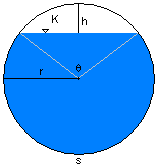Hydraulic Radius Equations Formulas Calculator
Open Channel Flow Fluid Mechanics Hydraulics
Problem:
Solve for hydraulic radius.
Enter Inputs:
Can you share this page? Because, it could help others.
Solution:
Solution In Other Units:
Input Conversions:
Change Equation or Formulas:
Tap or click to solve for a different unknown or equation
| hydraulic radius | |
| area of section flow | |
| wetted perimeter | |
 | hydraulic radius of a pipe |
| mean depth | |
| area of section flow | |
| top water surface width |
| Froude number | |
| flow velocity | |
| acceleration of gravity | |
| mean depth |
Hydraulic Radius: Understanding its Importance in Fluid Dynamics
Hydraulic radius is a fundamental concept in fluid dynamics that plays a crucial role in analyzing and understanding flow in open channels. It measures the flow efficiency in a channel by considering the relationship between the cross-sectional area and the wetted perimeter. This article explores the importance of hydraulic radius in fluid dynamics, discusses the equation, wetted perimeter, and section flow area, explains how to solve for it, provides examples of its application, confers the fields and degrees in which it is used, highlights common mistakes, and explore its practical applications.
Importance in Fluid Dynamics
The hydraulic radius is significant in fluid dynamics for several reasons:
- Flow Efficiency: Hydraulic radius provides insights into flow efficiency in open channels, considering the relationship between the channel's cross-sectional area and the wetted perimeter. High hydraulic radius values indicate more efficient flow, while low values suggest flow restrictions or inefficiencies.
- Flow Velocity: Hydraulic radius influences flow velocity, a critical parameter in fluid dynamics. It helps determine the speed at which water or any fluid travels through a channel, aiding in hydraulic system design and analysis.
- Flow Resistance: Hydraulic radius affects the resistance encountered by fluid as it flows through a channel. A larger hydraulic radius reduces flow resistance, resulting in a smoother passage of water and minimizing energy losses.
Equation, Wetted Perimeter, and Section Flow Area
The hydraulic radius (R) is calculated using the following equation:
R = A / P
Where:
- R is the hydraulic radius.
- A is the cross-sectional flow area of the channel.
- P is the channel-wetted perimeter.
The wetted perimeter (P) represents the length of the channel's boundary in contact with the flowing fluid. It can be calculated by summing the lengths of all the sides of the channel cross-section parallel to the flow.
The section flow area (A) represents the cross-sectional area of the channel occupied by the flowing fluid. It is typically determined by measuring the dimensions of the cross-section and applying appropriate geometric formulas.
Solving for Hydraulic Radius
To solve for the hydraulic radius (R), you need to know the cross-sectional flow area (A) and the wetted perimeter (P) of the channel. Once you have obtained these values, divide the flow area by the wetted perimeter to calculate the hydraulic radius using the earlier equation.
Examples of Applications
Hydraulic radius finds application in various fields, such as:
- Civil Engineering: Hydraulic radius is used to design and analyze open channels, irrigation systems, and drainage systems.
- Hydrology: It plays a crucial role in hydrological studies, flood modeling, and river flow analysis.
- Environmental Engineering: Hydraulic radius helps assess and manage water resources, including river restoration projects and water supply systems.
- Fluid Mechanics: It analyzes and understands fluid flows in pipes, channels, and other hydraulic systems.
- Geomorphology: Hydraulic radius aids in studying river and stream morphology, including sediment transport and erosion processes.
Common Mistakes
Here are ten common mistakes that people often make when dealing with hydraulic radius:
- Misinterpreting the hydraulic radius as a linear measurement rather than a ratio.
- Incorrectly calculating the wetted perimeter or flow area of a channel.
- Neglecting to consider the effects of irregular or non-prismatic channel shapes.
- Assuming a constant hydraulic radius throughout a channel with variable flow depth.
- Failing to update the hydraulic radius value when the flow depth changes.
- Overlooking the effects of sediment deposition or vegetation growth on the channel cross-section.
- Using incorrect units during calculations leads to inaccurate results.
- Ignoring the impact of cross-sectional variations in practical applications.
- Neglecting the effects of channel roughness on hydraulic radius calculations.
- Considering hydraulic radius alone without examining other hydraulic parameters to analyze flow characteristics.
Practical Applications
Hydraulic radius is used extensively in practical applications, including:
- Designing and modeling water supply networks and open-channel systems.
- Determining the efficiency and capacity of drainage systems and culverts.
- Calculating flow rates and velocities in rivers, streams, and canals.
- Analyzing sediment transport and erosion processes in river systems.
- Performing hydraulic calculations for dam and reservoir designs.
In summary, hydraulic radius is a fundamental concept in fluid dynamics that provides critical insights into flow efficiency and velocity. By considering the relationship between cross-sectional flow area and wetted perimeter, hydraulic radius helps analyze and design hydraulic systems in various fields such as civil engineering, hydrology, and environmental engineering. It is essential to understand the equation, wetted perimeter, and section flow area while avoiding common mistakes to apply hydraulic radius in practical applications correctly.
References - Books:
U.S. Department of the Interior Bureau of Reclamation. Water Resources Research Laboratory: Water Measurement Manual. Washington DC, 2001.
Lindeburg, Michael R. 1992. Engineer In Training Reference Manual. Professional Publication, Inc. 8th Edition.
Online Web Apps, Rich Internet Application, Technical Tools, Specifications, How to Guides, Training, Applications, Examples, Tutorials, Reviews, Answers, Test Review Resources, Analysis, Homework Solutions, Worksheets, Help, Data and Information for Engineers, Technicians, Teachers, Tutors, Researchers, K-12 Education, College and High School Students, Science Fair Projects and Scientists
By Jimmy Raymond
![]()
Contact: [email protected]
Privacy Policy, Disclaimer and Terms
Copyright 2002-2015